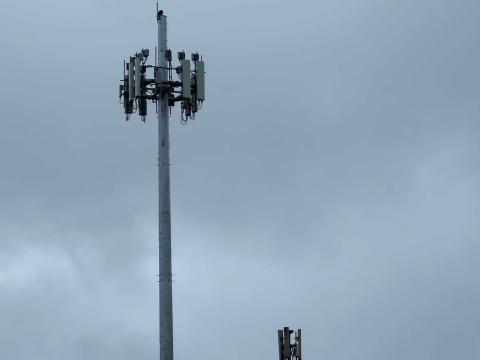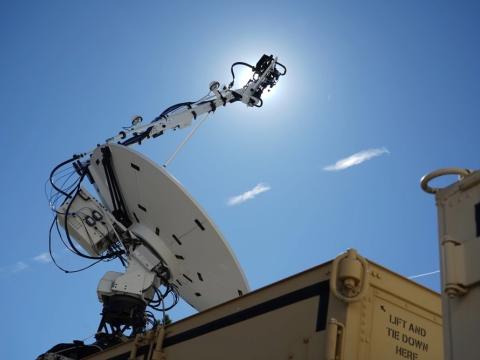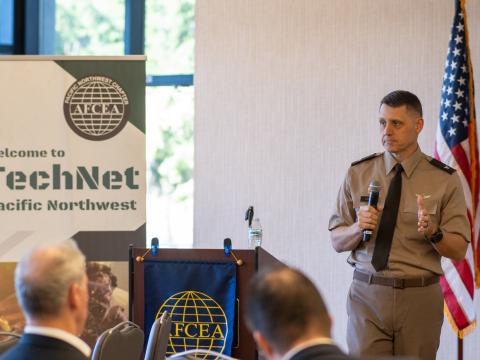Coalition Forces Examine Communications Capabilities
 |
| To ensure that the Coalition Warrior Interoperability Demonstration (CWID) execution phase reflects real-world conditions, planners monitor news channels and may add variations of actual events to the scenarios. |
A long-established military event that originated as an examination of interoperability has evolved into a forum for perfecting the art and science of information sharing. Featuring a new network architecture, expanded staffs and more technology trials, this year’s Coalition Warrior Interoperability Demonstration generated an abundance of evaluation data that will help improve collaboration in current and future operations.
One look at the makeup of the Coalition Warrior Interoperability Demonstration (CWID) reveals that more than just the name changed in 2005. The event, formerly called the Joint Warrior Interoperability Demonstration, led the way in a number of groundbreaking initiatives. A classified coalition network was created that allowed information sharing among all nation participants. When appropriate, virtual private network (VPN) technology enabled participants to designate with whom they wanted to share specific information. The scenario was expanded to include joint operations between
This year, the U.S. Joint Forces Command (JFCOM),
Technologies vying to participate in the demonstration had to satisfy at least one of the objectives: mission assurance; situational awareness; information sharing across multiple domains; collaborative planning across a bandwidth-constrained operational environment; enhanced sharing of intelligence, surveillance and reconnaissance information; in-transit security of information; language translation; and responsive effective logistics.
The event’s name change also more accurately reflects CWID 2005 participation. In addition to U.S. participants located at several sites, personnel in Denmark, France, Germany, Hungary, Italy, Norway, Poland and the United Kingdom participated in the event. Personnel from the
To help determine the usefulness of capabilities to warfighters and emergency personnel today, the interoperability trials took place in an integrated operational environment. One scenario involved national emergency situations within the continental
The homeland defense threat scenario included a train derailment near the U.S. Capitol and terrorist attacks on bridges in
As in past demonstration scenarios, the CTF setting involved fictional countries. The southeastern area of the
The 11-day scenario was presented in five days of activities. These efforts were divided into three phases: setting up bases of operation, executing operations and delivering humanitarian assistance.
Over the years, the demonstration’s network configuration has evolved to reflect changing needs. For past events, the participants operated using the classified Combined Federated Battle Laboratories Network (CFBLNet) and the unclassified Defense Information System Network–Leading Edge Services (DISN-LES). This year, the CWID networks used the DISN-LES as the backbone; Type 1 encryption protected the classified communications traffic. However, the requirement for scalability and flexibility called for the creation of a new classified coalition space called the Coalition Secret Network, or Purple Enclave. The enclave was set up as a temporary security network with its own set of services specifically designed to meet CWID requirements.
Unlike the CFBLNet, the Purple Enclave environment was classified; however, the information was releasable to all nations participating in CWID. Countries were arranged into communities of interest and were separated by a VPN and firewall managers that protected communications without using Type 1 encryption devices.
According to Lt. Col. Buddy Dees, USAF, DISA’s CWID director, the event’s designers decided to create a classified network that was open to all coalition force participants at the beginning of the event’s preparations. “The fact that everyone agreed that information put on that enclave was releasable to all participants allowed us to have a stronger coalition exchange of information. If you wanted to share certain information only with country X, we had VPNs set up to do that. I could send that information over that network, and it would go only to that country. It’s really testing the trust of the VPN technology, which is what we’re pursuing,” Col. Dees says.
Col. Michael Lebiedz, USAFR, CWID director, JFCOM, says that participants were somewhat anxious about the amount of information sharing the Purple Enclave allowed; however, during the execution stage it worked well, and the network was solid, stable and better than in past demonstrations. “There was some concern when we first broached the idea of the Purple Network. But once everyone understood the concept and how it was going to work, everybody embraced it. Instead of a reluctance to share and a desire to protect information, there was much more of a need-to-share attitude,” Col. Lebiedz notes.
Transferring this willingness to share information to real-world operations will require both cultural and policy changes, he adds, and countries will have to agree about information-sharing policies as coalitions are being formed.
In addition to the Purple Enclave, NORTHCOM required two major network enclaves: warfighter and homeland defense/homeland security. The former was set up as a secret network for coalition and guest nations; the latter was the homeland security network and was built as a subset of the DISN-LES architecture.
The ability to communicate within a coalition network impressed
Although Col. Timothy Cassidy, USMCR, CTF commander for CWID, agrees that the communication links worked well, he says the demonstration revealed shortcomings that still need to be addressed. For instance, establishing interoperability between the continental
 |
| Lt. Col. James A. “Tony” Hill, New Zealand Army, coalition task force operations officer, CWID, completes his daily situation report from his post at the Naval Surface Warfare Center. |
And although CWID’s execution phase features all the hands-on activities, the assessment phase is equally important. Col. Lebiedz says that demonstration planners emphasized the need to collect data from operators, warfighters and contractors. “There were a number of different initiatives, and I think it will make our post-execution job much easier. JFCOM has a definite focus on pursuing trials that stand out and answer a capability shortfall,” the colonel says.
Col. Dees adds that in addition to the CWID questionnaires participants filled out each day, this year the U.S. Marine Corps distributed its own survey that focused on how technologies could benefit the Marines specifically. This information will be shared with all of the CWID assessors, he notes.
Vendors also were asked to provide subject matter experts who could train users during the execution phase. Col. Dees relates that some of the interoperability trials that did not perform well at the beginning of the event were those offered by contractors that did not send trainers. Once this issue was addressed, the number of positive comments about capabilities increased significantly, he says.
Training from vendors definitely improved participants’ experience with the technologies, but the learning experience went far beyond discovering what some capabilities were designed to do, Col. Lebiedz says. On several occasions, participants sitting next to each other began ad hoc collaboration, many staying after official work hours to try new ideas, he states.
The brainstorming that occurred at CWID came as no surprise to Col. Hill. “Warfighters by nature like to adapt and improvise. One of the recurring comments we got back from contractors was that the participants found new applications for their products that even they did not know about. I think that was a surprise for them as well. For me, that was one of the high points of CWID—the ability, as a warfighter, to say to these guys, ‘give this a bit of a tweak’ or ‘adjust this’ or ‘we’re doing this with it.’ The focus was always on making the product better for the guy on the ground, the warfighter,” he says.
Col. Lebiedz agrees that CWID’s participants were not shy about pushing the technology envelop in some cases. “That’s why we need this kind of venue. Nobody’s going to die if you push the wrong button, and that’s the bottom line,” he says.
According to Col. Cassidy, CWID was a classroom for contractors as well. Many observed a coalition staff environment during operations for the first time. While conducting missions within the scenarios, military personnel explained their requirements to vendors who, in some cases, could provide solutions and in others, could not. This give-and-take helps companies understand shortfalls in current products, which in turn will help them improve solutions in the future. “It’s a building process, and it works well both ways,” Col. Cassidy says.
Col. Lebiedz notes that work begins in earnest when the trials end. “Our challenge now is to sort out what worked and what didn’t, capture that information as objectively and accurately as possible, and make follow-on decisions that could involve either attempting to field a solution or putting them [the solutions] on a track for further evaluation such as into another venue or a prototype effort,” he says. Some items could be moved into an advanced concept technology demonstration program, he adds.
The follow-on work involves more than just assessing the effectiveness and value of the solutions, Col. Cassidy explains. Issues such as funding must be addressed to ensure that the best equipment can be put into the field as quickly as possible to support warfighters in current operations, he says.
This focus on the warfighter amazed Col. Hill. “What surprised me the most was the passion of the participants that were here—whether a contractor or military—to do the right thing for the people who are going to war. That’s something we don’t see a lot of far south of the equator. We have it, but it’s not as upfront with people showing their product. I got the impression that everyone here was trying to help the guys who are at the front, to save their lives,” he says.
With planning for CWID 2006 underway, Col. Cassidy already has identified some possible improvements. For example, in 2004, the EUCOM staff was not part of the CTF command structure. This year, EUCOM and NORTHCOM staffs were established and collaboration was possible, but Col. Cassidy says he would like to see this interplay increased in 2006 when EUCOM is the host combatant command for the event.
Web Resources
Coalition Warrior Interoperability Demonstration: www.cwid.js.mil
CWID 2006 Federal Business Opportunity Announcement: http://199.57.1.137/public/CWID%202006%20Website%20FBO.doc
Additional CWID resources: www.afcea.org/signal/cwid




Comments